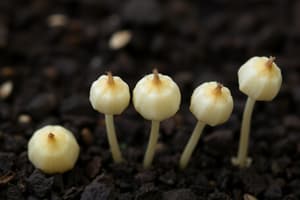Podcast
Questions and Answers
Explain seed dormancy and the factors that prevent seeds from germinating under favorable environmental conditions.
Explain seed dormancy and the factors that prevent seeds from germinating under favorable environmental conditions.
Seed dormancy is the state in which seeds are prevented from germinating even under favorable environmental conditions. Factors that prevent germination include temperature, water, light, gas, seed coats, and other mechanical restrictions. Seeds require a period of rest before being capable of germination.
What are the major causes of seed dormancy?
What are the major causes of seed dormancy?
The major causes of seed dormancy include innate dormancy, enforced dormancy, and induced dormancy. Innate dormancy refers to seeds being incapable of germination even under suitable conditions. Enforced dormancy is caused by environmental restraints like moisture, oxygen, light, and temperature. Induced dormancy occurs when seeds have imbibed water but are placed under extremely unfavorable conditions for germination.
What are the types of seed dormancy?
What are the types of seed dormancy?
The types of seed dormancy are innate dormancy, enforced dormancy, and induced dormancy. Innate dormancy refers to seeds being incapable of germination even if conditions for growth are provided. Enforced dormancy is caused by environmental restraints, while induced dormancy occurs when seeds are placed under extremely unfavorable conditions for germination.
Explain innate dormancy and provide an example of its cause.
Explain innate dormancy and provide an example of its cause.
What is induced dormancy and how does it occur?
What is induced dormancy and how does it occur?
What are the natural methods of breaking seed dormancy?
What are the natural methods of breaking seed dormancy?
What are the artificial methods used for breaking seed dormancy?
What are the artificial methods used for breaking seed dormancy?
What is the process of scarification in seed coat treatment?
What is the process of scarification in seed coat treatment?
How does stratification help in breaking seed dormancy?
How does stratification help in breaking seed dormancy?
What is the importance of seed dormancy?
What is the importance of seed dormancy?
Flashcards are hidden until you start studying
Study Notes
Seed Dormancy
- Seed dormancy is a state in which seeds fail to germinate even under favorable environmental conditions, despite having sufficient water, oxygen, and appropriate temperature.
- This delay in germination allows seeds to adapt to their environment and ensure successful reproduction.
Causes of Seed Dormancy
- Abscisic acid (ABA), a plant hormone, inhibits seed germination, promoting dormancy.
- Hormonal imbalance, such as high ABA and low gibberellin (GA) levels, contributes to dormancy.
- Seed coat impermeability, physical barriers, or chemical inhibitors can prevent water uptake and germination.
Types of Seed Dormancy
- Innate dormancy: a natural, innate characteristic of certain species, often due to seed coat thickness or impermeability, e.g., lotus seeds have innate dormancy due to their hard, impermeable seed coat.
- Induced dormancy: a state of dormancy that develops in response to environmental factors, such as temperature fluctuations, light, or water availability.
Innate Dormancy
- Example: lotus seeds have innate dormancy due to their hard, impermeable seed coat, which prevents water uptake and germination.
Induced Dormancy
- Induced dormancy occurs when seeds are exposed to unfavorable environmental conditions, such as high temperatures, drought, or darkness.
- This type of dormancy is reversible, and seeds can germinate once favorable conditions are restored.
Breaking Seed Dormancy
-
Natural Methods:*
-
Stratification: exposure to changing temperature and moisture conditions, mimicking natural seasonal fluctuations, helps break dormancy.
-
Scarification: soaking or scratching the seed coat to allow water uptake and germination.
-
Artificial Methods:*
-
Seed coat treatment: chemical or mechanical scarification to facilitate water uptake.
-
Stratification: controlled temperature and moisture regimes to break dormancy.
-
Hormone treatment: applying GA to overcome ABA's inhibitory effects.
Scarification Process
- Scarification involves scratching or nicking the seed coat to allow water uptake and germination.
- This process can be done mechanically (e.g., sandpaper) or chemically (e.g., sulfuric acid).
Importance of Seed Dormancy
- Seed dormancy ensures that seeds only germinate when environmental conditions are favorable, increasing chances of successful reproduction.
- Dormancy allows seeds to survive harsh conditions, such as winter or drought, and germinate when conditions improve.
Studying That Suits You
Use AI to generate personalized quizzes and flashcards to suit your learning preferences.




